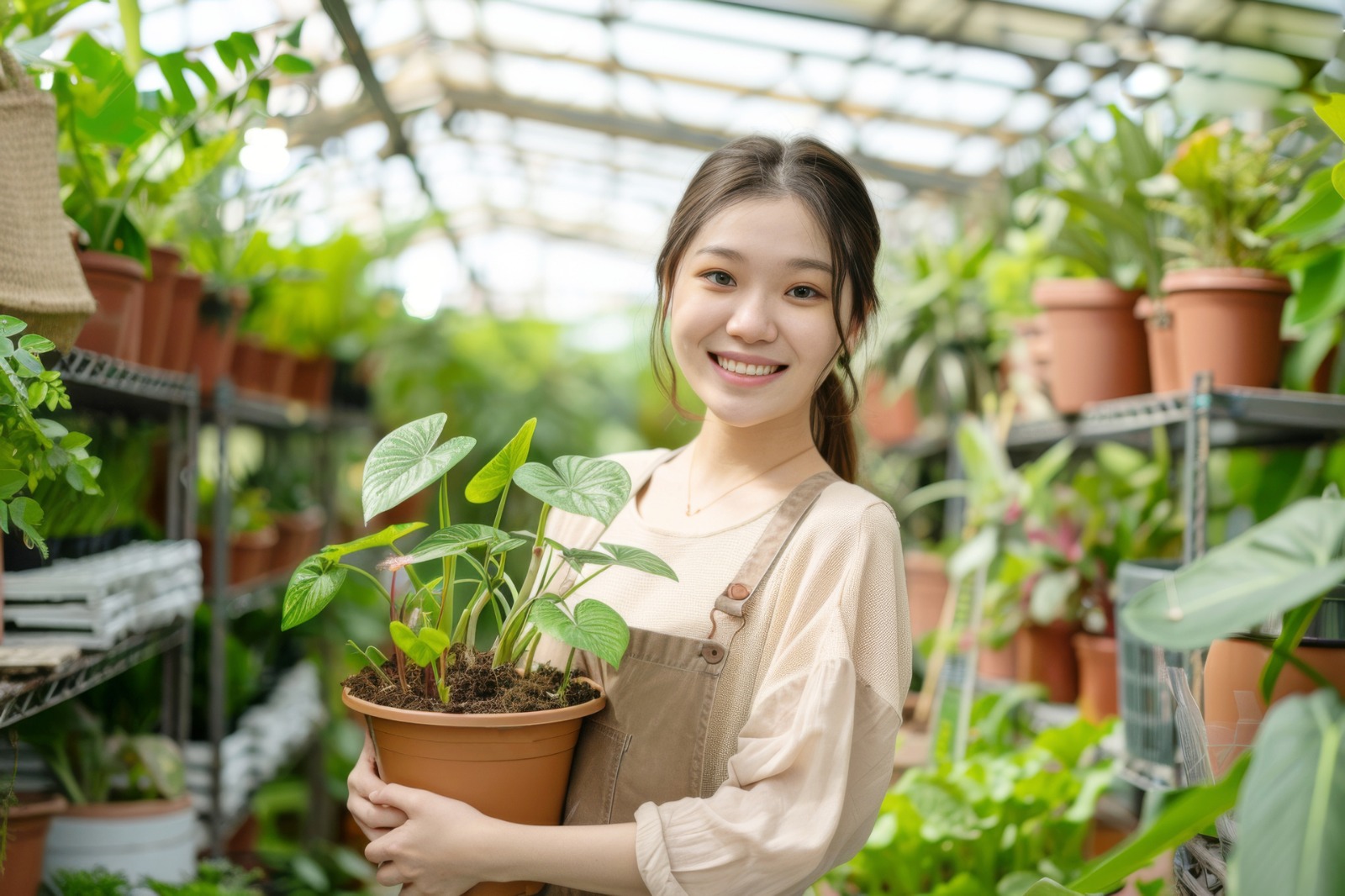
Building a greenhouse for the first time is an extremely rewarding and exciting journey, from choosing the right location and materials to figuring out the setup and maintenance.
Why Build or Buy a Greenhouse?
A greenhouse acts as a safe haven that protects plants from pests and insects and other potential outdoor elements, such as torrential rain, cold winters, and extreme heat.
You can grow anything from a vegetable garden to an array of delicate flowers, a tropical oasis, or a collection of cacti and succulents.
However, not every greenhouse is built the same way.
When building or buying a greenhouse, one critical factor is that your setup satisfies your gardening objectives and budget. You should also consider what type of plants you plan to grow, as this will make it easier later on to regulate the amount of light and heat in the greenhouse. For example, ferns and orchids will require lower light conditions than vegetable gardens or succulent collections.
In this guide to buying and building a greenhouse, we will discuss the key considerations for creating a perfect greenhouse to nurture your plants year-round.
Step 1: Choose the Right Location and Size before buying or building a greenhouse.
Selecting the Right Location While Building Your Green House
Location is often crucial. Find a space in your garden that is convenient for daily plant maintenance and has easy access to water and electricity.
Garden Space Fit: Your greenhouse should not encroach on your walkway or other outdoor plants. Ensure that the ground is level where you want it to go. That way, it's easier to build a solid, uniform foundation.
Outdoor Green House and Indoor Green House
Outdoor Greenhouse: Designed to capture natural sunshine and shield plants from harsh weather conditions, an outdoor greenhouse is a standalone building that may be placed in a garden or yard. It offers a regulated atmosphere with temperature, humidity, and ventilation controls, making it perfect for growing a range of plants all year round.
Indoor Greenhouse: Usually located in places with enough sunlight, an indoor greenhouse is a small, frequently portable arrangement intended for indoor use. It is ideal for tiny plants, herbs, or seedlings because it provides a regulated microclimate that keeps things warm and humid even in small spaces.
2. Why Size Matters
Start a Little Bigger: As your plant collection expands, first-time greenhouse owners frequently discover that they need more room. Consider a slightly bigger size to account for potential future growth if possible.
Improved Air Circulation: Good airflow is crucial for healthy plants, particularly in smaller greenhouses. Ensure that you have options to close and open doors and windows to create natural airflow. You may need to use fans during summer, so allowing for a power point inside the greenhouse will be very handy. Generally, it is easier to maintain stable conditions in a larger greenhouse than in a smaller one.
Step 2: Optimize for Sun and Shade
1. Balancing Sunlight and Shade
Sunlight Requirements: Although greenhouses require sunlight and shade, it's essential to strike the correct balance between the two, particularly in the spring and fall. A greenhouse that doesn't overheat while capturing enough light for warming is necessary throughout these seasons.
Place your greenhouse so its length extends east to west to get the most sunlight. This alignment captures more sunlight throughout the day, which is advantageous in cooler months and can save winter heating expenses, particularly in colder climates.
2. Seasonal Sun Protection
Protection in Summer: Use shading materials or retractable shade cloth to keep plants safe from the hot summer sun, which can quickly cause the greenhouse to overheat.
To determine the correct size, measure the length and width of your greenhouse. When measuring a greenhouse, avoid excessive length to prevent overhangs on the end walls. The shade cloth should cover only the top, extending to the hip board. Secure it using shade cloth clips with a loop for tying off with rope.
Step 3: Setting Up Your Greenhouse at the Right Time
Early spring or autumn are ideal for setting up plants in your new greenhouse. Although constructing a greenhouse can be done at any time of the year, it is best to do so during spring or autumn. This will allow your plants to gradually adjust to the new conditions. Plants will be better prepared to flourish when the weather changes, helping you avoid the intense summer heat or cold winter.
Installing a greenhouse before winter can also give plants a place to stay throughout the colder months.
Step 4: Consider Your Budget and Greenhouse Types
1. Having a Realistic Budget
Invest in Quality: Purchasing high-quality greenhouse materials upfront might reduce the need for replacements and repairs. Under Australian weather conditions, inexpensive materials may deteriorate rapidly.
2. Types of Greenhouses
Glass Greenhouses: Distinguished by their exceptional light transmission and longevity, they are aesthetically pleasing and efficient insulators. Because they are heavier, they require a sturdier structure and a firm foundation.
Polycarbonate Greenhouses: Lighter and better insulated than glass, polycarbonate greenhouses are a common substitute. Although single-layer walls can make temperature regulation more difficult, thicker polycarbonate (8mm or more) gives better durability.
Other Materials: Although inexpensive, temporary constructions like hoop homes might not last as long as alternatives made of glass or polycarbonate. They're a nice temporary fix if you're experimenting with greenhouse gardening.
Step 5: Build on a Strong Foundation
A strong foundation is essential for the greenhouse to be stable and long-lasting. The foundation shields the greenhouse from the outdoors, stops water seepage, and keeps it from shifting. Two well-liked foundation choices are as follows:
Concrete Slab: incredibly resilient to weather and long-lasting, however more expensive
Gravel or Decomposed Granite Base: A less expensive option than concrete also easier and quicker to install.
Building a sturdy foundation will guarantee that your greenhouse can endure seasonal fluctuations without experiencing significant structural problems.
Step 6: Plan for Climate Control and Automation
1. Ventilation
Vents help circulate air to ensure the greenhouse remains at a constant temperature. By opening and closing in response to the interior temperature, vents help to regulate the greenhouse's inside temperature.
As hot air rises, you will need to install vents close to the ground level, and some need to be located close to the roof. This will allow fresh air to be drawn inside the greenhouse while the hot hair will be pushed out through the upper vents.
The bottom vents can usually be operated manually as needed, according to the season. However, the roof vents should be set so they open and close automatically depending on the inside temperature. The most widely used method is to use an automatic window opener. These openers can automatically open and close the greenhouse windows to control the greenhouse temperature when the temperature changes. They don't consume energy, batteries, or electricity and are generally inexpensive.
2. Climate Control Options
Ceiling fans powered by solar energy circulate air without increasing electricity bills. Increased ventilation lowers humidity and keeps your greenhouse cool in the summer, avoiding problems like mould.
Humidity Control: Install a hygrometer or dehumidifier to maintain the proper moisture levels, which are crucial for plant health. The type of plants you grow in your greenhouse will also affect this.
Step 7: Maintenance Tips for Longevity
1. Invest in Quality Materials and Upkeep
Using premium materials for climate systems, plant pots, and shelves is essential to greenhouse maintenance. By investing a little extra in long-lasting accessories, you can avoid the trouble and expense of replacements.
2. Regular Checks
Monthly Checks: Examine the greenhouse's structure for signs of deterioration, wear, or leaks. To get the most sunshine, clean windows frequently and check for condensation on glass or polycarbonate.
Seasonal Prep: Increase shading before summer and strengthen insulation before winter. With regular maintenance, your greenhouse will function at its peak throughout the year.
Best greenhouse plants in Australia
Popular choices include tropical plants like Monstera, Philodendron, and Begonias, which flourish with greenhouses' warmth and humidity. Edible plants, such as tomatoes, cucumbers, and capsicums, are common as greenhouses extend their growing season.
Most succulents and cacti collections benefit from growing in a greenhouse, which allows you to fully control how much and when they receive water.
Other species commonly grown in a greenhouse include Geraniums and many species of orchids as they require consistent temperature and protection from harsh outdoor conditions.
Final Thoughts
From extending your growing season to caring for delicate or uncommon species, a greenhouse is a great addition to any garden. You may position yourself for long-term success by meticulously organizing every stage, from setup and maintenance to location and resources.
Check out PlantArk's blog to learn more about gardening, plant care, and other topics.
You may buy and sell plants and seeds for your gardening needs on PlankArk, an Australian plant marketplace.


